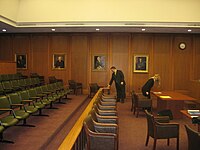
Back آزمون پذیرش مدرسه حقوق Persian Tes Masuk Sekolah Hukum ID LSAT Korean Law School Admissions Test Dutch LSAT Russian 法学院入学考试 Chinese
| Acronym | LSAT |
|---|---|
| Type | Standardized test |
| Administrator | Law School Admission Council |
| Skills tested | Reading comprehension, logical reasoning, and (unscored) writing[1] |
| Purpose | Admissions to Juris Doctor programs of law schools in the US, Canada, and some other countries[citation needed] |
| Year started | 1948 |
| Duration | 35 minutes for each of the 4 sections, for a total of 2 hours and 20 minutes (excluding breaks) + 50 minutes for Writing section |
| Score range | 120 to 180, in 1 point increments |
| Score validity | Scores of up to 12 tests taken since 1 June 2008 are valid |
| Offered | As of 2023, 9 times a year, with dates listed on the LSAC website. |
| Restrictions on attempts | Starting August 2023, no more than 5 attempts in 5 years, no more than 7 attempts in a lifetime. Exceptions may be granted for special circumstances.[2] |
| Regions | Worldwide |
| Languages | English |
| Annual number of test takers | |
| Fee | LSAT fee: US$238 CAS fee: US$207 |
| Used by | Law schools in the US, Canada, Australia and some other countries[citation needed] |
| Website | www |
| Legal education in the United States |
|---|
 |
| Stages |
| Exams and licensure |
| Organizations |
| Country | Number of applicants |
|---|---|
| Canada | |
| China | |
| South Korea | |
| India | |
| Mexico | |
| Nigeria | |
| United Kingdom | |
| Colombia | |
| Jamaica | |
| Russia | |
| Pakistan | |
| Brazil |
The Law School Admission Test (LSAT /ˈɛlsæt/ EL-sat) is a standardized test administered by the Law School Admission Council (LSAC) for prospective law school candidates. It is designed to assess reading comprehension and logical reasoning.[5] The test is an integral part of the law school admission process in the United States, Canada (common law programs only), the University of Melbourne, Australia,[6][7][needs update] and a growing number of other countries.[citation needed]
The test has existed in some form since 1948, when it was created to give law schools a standardized way to assess applicants in addition to their GPA.[8] The current form of the exam has been used since 1991. The exam has four total sections that include three scored multiple choice sections, an unscored experimental section, and an unscored writing section. Raw scores on the exam are transformed into scaled scores, ranging from a high of 180 to a low of 120, with a median score typically around 150. Law school applicants are required to report all scores from the past five years, though schools generally consider the highest score in their admissions decisions.
Before July 2019, the test was administered by paper-and-pencil. In 2019, the test was exclusively administered electronically using a tablet.[9] In 2020, due to the COVID-19 pandemic, the test was administered using the test-taker's personal computer. Beginning in 2023, candidates have had the option to take a digital version either at an approved testing center or on their computer at home.
- ^ "About the LSAT". www.lsac.org. Archived from the original on 2 March 2018. Retrieved 30 April 2018.
- ^ "Frequently Asked Questions about the LSAT". www.lsac.org. Retrieved 5 May 2024.
- ^ "LSATs Administered". lsac.org. Archived from the original on 7 April 2018. Retrieved 30 April 2018.
- ^ LSAC. "The Law School Admission Council (LSAC)". www.lsac.org. Archived from the original on 14 April 2018. Retrieved 30 April 2018.
- ^ "About the Law School Admission Council". Lsat.com. Archived from the original on 10 February 2012. Retrieved 22 July 2013.
- ^ "Apply to study the JD in Australia". Lsac.org. Archived from the original on 2 August 2013. Retrieved 22 July 2013.
- ^ "About the LSAT". Law.unimelb.edu.au. 25 October 2012. Archived from the original on 31 July 2013. Retrieved 22 July 2013.
- ^ "Archived copy" (PDF). Archived from the original on 26 November 2010. Retrieved 26 November 2010.
{{cite web}}: CS1 maint: archived copy as title (link) CS1 maint: bot: original URL status unknown (link) - ^ "LSAT Test Changes: The Digital LSAT – Kaplan Test Prep".